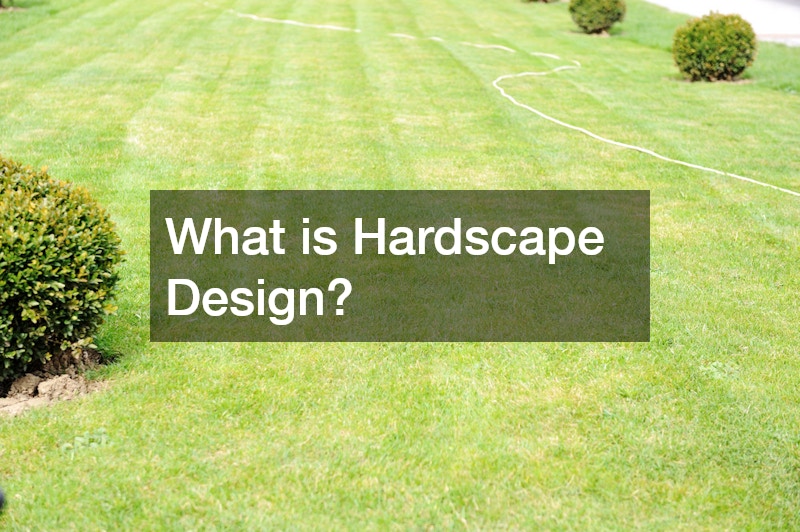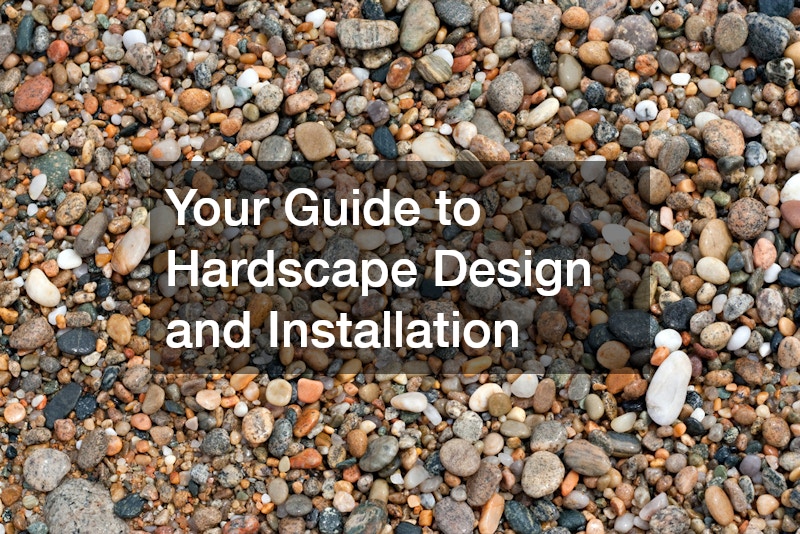Outdoor spaces are an extension of our living environments, and hardscaping plays a crucial role in defining their character, utility, and beauty. Hardscape design and installation refer to the non-living elements in landscaping — from patios and pathways to retaining walls and pergolas — that form the structural backbone of your yard. These features not only provide functionality but also elevate the visual appeal of any outdoor area. Whether you’re creating a peaceful backyard retreat or a vibrant space for entertaining, thoughtful hardscape design can transform your landscape into a stunning and purposeful extension of your home.
In collaboration with other professionals such as a landscaping contractor, roofer, or excavating contractors, a well-rounded outdoor design can dramatically enhance both aesthetics and value. Coordinating these elements ensures each aspect of your property works harmoniously, from top to bottom.
What is Hardscape Design?

Defining Hardscape
Hardscape encompasses all the man-made, non-plant elements of a landscape. It includes everything from walkways, decks, and fences to water features and fire pits. Essentially, if it’s a solid structure or constructed element in your outdoor space, it falls under the umbrella of hardscaping.
Differences Between Hardscape and Softscape
While hardscape refers to the built, inorganic aspects of a yard, softscape pertains to the organic, living components such as trees, shrubs, grass, and flowers. Lawn care typically falls under the softscape category, involving mowing, fertilizing, and maintaining healthy vegetation. Both elements work in tandem to create a balanced landscape.
Common Materials Used in Hardscape
Hardscape elements can be built using a variety of materials, depending on the desired look, function, and budget. Common materials include natural stone, concrete, brick, wood, gravel, and synthetic products like composite decks. Each material has its advantages in terms of durability, aesthetics, and maintenance.
Hardscape Design Principles
Hardscape design requires careful planning and an eye for detail. Core principles include balance, unity, proportion, and rhythm. Balance ensures visual harmony, unity ties different elements together, proportion maintains scale between features, and rhythm helps guide the eye throughout the space. A well-designed hardscape integrates seamlessly into the natural environment and complements the home’s architectural style.
Examples of Hardscape Features
Popular hardscape features include patios for outdoor dining, stone walkways that guide movement, retaining walls for erosion control, built-in seating areas, pergolas for shade, and water features like fountains or ponds. Many homeowners are also turning to glass patio enclosures, which combine transparency and protection to create year-round outdoor living areas.
Why is Hardscape Design Important?
Enhancing Aesthetic Appeal
One of the foremost reasons homeowners invest in hardscaping is to improve the visual appeal of their property. Thoughtfully chosen materials and designs can accentuate the architecture of your home and create a cohesive and inviting outdoor environment.
Improving Functionality
Hardscape features provide structure and usability to outdoor spaces. Patios create areas for socializing and dining, pathways make navigation easier, and retaining walls can shape sloped landscapes into usable levels. These elements turn otherwise unusable parts of a yard into purposeful zones.
Increasing Property Value
Professionally designed and installed hardscape features can significantly increase the resale value of a property. Curb appeal matters, and buyers often appreciate low-maintenance, attractive outdoor spaces that are ready for use. When paired with complementary elements like asphalt service driveways or composite decks, your outdoor area becomes a true investment.
Complementing Landscaping
Hardscape and softscape are two sides of the same coin. A well-balanced landscape uses hardscape to frame and support the natural beauty of plants and greenery. Stone borders can define flower beds, while patios provide a clean edge to grassy lawns. Access to quality landscaping products ensures that every element — from plants to pavers — works together seamlessly.
Sustainability Considerations
Hardscaping can support sustainable landscaping practices. Permeable pavers, for instance, help reduce runoff and promote groundwater recharge. Strategically placed features can also help with erosion control and improve drainage, which supports a healthier overall ecosystem. Using top soil and native plants further enhances sustainability by promoting healthy growth and reducing the need for excessive irrigation.
How to Plan a Hardscape Design?
Assessing Your Space
Begin by thoroughly evaluating your outdoor area. Take note of the topography, existing vegetation, sun and shade patterns, and any problem areas such as poor drainage. Partnering with excavating contractors during this phase can help identify and address foundational issues like soil compaction or grading before construction begins.
Setting a Budget
Establishing a realistic budget early in the planning process ensures that your design remains financially feasible. Factor in the cost of materials, labor, design services, permits, and potential maintenance. Being upfront about your budget also helps designers tailor plans to your financial comfort zone.
Choosing Design Elements
Select the features that best meet your lifestyle needs. Do you entertain often? A spacious patio or outdoor kitchen might be ideal. Seeking tranquility? A water feature or meditation area could be the focus. Choose elements that align with how you intend to use the space.
Drafting a Layout
Sketch out your ideas or work with a landscape designer to create a detailed layout. Consider the flow of movement, zones for different activities, and visual connections between elements. Good design is both functional and aesthetically pleasing, maximizing the potential of your space.
Consulting a Professional Designer
Hiring a professional landscaping contractor can bring your vision to life with expert insight and technical knowledge. Designers help avoid common pitfalls, ensure proper site preparation, and provide access to quality landscaping products and trusted contractors for every phase of the project.
What Materials are Best for Hardscape Installation?

Natural Stone Options
Natural stone, such as flagstone, slate, and granite, offers unmatched beauty and durability. Its unique textures and colors blend seamlessly into natural landscapes. While often more expensive, stone is long-lasting and adds a touch of elegance to any design.
Benefits of Concrete
Concrete is versatile and cost-effective, making it a popular choice for patios, driveways, and walkways. It can be poured in custom shapes and colored or stamped to mimic more expensive materials like stone or tile, offering both practicality and aesthetic flexibility.
Brick Pavers and Their Uses
Brick pavers provide a classic, timeless look and are especially well-suited to traditional or colonial-style homes. They are highly durable and relatively easy to replace or repair. Brick is often used for walkways, patios, and decorative borders, especially when coordinated with asphalt service areas for a consistent theme.
Wood in Hardscaping
Wood brings warmth and natural appeal to outdoor spaces. It’s commonly used for decks, pergolas, fences, and raised planters. While it requires more maintenance than stone or concrete, wood is unmatched in creating cozy, inviting atmospheres. For a lower-maintenance alternative with similar aesthetics, many homeowners now opt for composite decks.
Synthetic Materials
Synthetic options like composite decking and plastic pavers offer the look of natural materials with less maintenance. They’re resistant to weathering, rot, and insects, making them ideal for homeowners seeking long-term ease and reliability.
How to Ensure Durability and Longevity in Hardscape?
Site Preparation
Proper site preparation is crucial to the longevity of any hardscape installation. This includes clearing debris, grading the area, and addressing any drainage concerns. A solid foundation is the starting point for every successful project.
Layering and Compaction
Most hardscape installations require a base of gravel or crushed stone that is compacted in layers. This foundation supports weight and prevents settling or shifting over time. Skipping this step often results in uneven surfaces and premature failure.
Choosing Durable Materials
Opt for materials known for their strength and resistance to environmental factors. Natural stone, high-grade concrete, and weather-treated wood are all excellent choices. Durable materials may have a higher upfront cost, but they pay off in the long run through reduced repair and replacement needs.
Maintenance Tips
Regular maintenance extends the life of your hardscape. This includes cleaning surfaces, sealing pavers, checking for cracks, and removing weeds or moss from joints. Incorporating lawn care into your routine helps keep adjacent grass healthy and prevents it from encroaching into hardscaped areas.
Weather and Climate Considerations
Your local climate should influence material choices and design. In freeze-thaw zones, use materials that resist cracking and expansion. For hot, sunny climates, select surfaces that stay cool underfoot. Proper planning ensures your hardscape can withstand regional conditions.
What are the Costs Involved in Hardscape Installation?
Factors Influencing Costs
Several factors affect the cost of hardscaping, including the size of the project, the complexity of the design, and the choice of materials. Custom features, site access, and existing conditions like slopes or poor soil also impact overall pricing.
Material Costs Overview
Material prices vary widely. Natural stone tends to be the most expensive, followed by brick and decorative concrete. Synthetic options and basic poured concrete are usually more budget-friendly. For specific needs, sourcing high-quality landscaping products can make a big difference in value and longevity.
Labor Costs
Labor is a significant part of the budget, especially for projects that require skilled masonry or heavy machinery. Experienced contractors may charge more, but they also bring expertise that ensures quality results and fewer complications.
Permits and Regulations
Some projects require permits, especially those that alter grading or involve structural elements. Costs for permits vary by location but should always be factored into the overall budget. Compliance with local regulations prevents fines and project delays.
Cost-Saving Tips
To save money without sacrificing quality, consider phasing large projects over time, choosing cost-effective materials for less visible areas, and doing some of the prep or finishing work yourself. Always get multiple quotes and avoid low bids that may compromise workmanship.
How to Choose a Hardscape Contractor?

Evaluating Experience
Look for contractors with specific experience in hardscaping. Review their portfolio and ask about past projects similar to yours. A seasoned professional will have the knowledge to anticipate challenges and deliver superior results.
Checking References and Reviews
Ask for references and read online reviews to gauge customer satisfaction. Speaking with past clients can offer valuable insights into a contractor’s reliability, communication, and quality of work.
Understanding the Bidding Process
When collecting bids, ensure each one includes a breakdown of materials, labor, and other expenses. Be wary of bids that are significantly lower than others — they may cut corners or use inferior materials.
Reviewing Contracts Thoroughly
Always get a written contract that outlines the scope of work, payment schedule, warranties, and timeline. Read it carefully and ask questions before signing. A clear contract protects both you and the contractor.
Building a Relationship
Good communication is essential. Choose a contractor who listens to your ideas, offers constructive feedback, and keeps you informed throughout the process. Whether working with a roofer, excavating contractors, or a general landscaping contractor, collaboration ensures a cohesive and efficient outcome.
What are Common Mistakes in Hardscape Design and Installation?
Poor Planning
Skipping the planning phase often leads to wasted resources and unsatisfactory results. A successful hardscape project begins with a detailed design and a clear understanding of how the space will be used.
Ignoring Drainage Needs
Improper drainage can cause water pooling, erosion, and damage to hardscape features. Always account for water flow and use techniques like grading, French drains, or permeable materials to manage moisture.
Overlooking Maintenance
Even the most beautiful hardscape requires upkeep. Failing to plan for maintenance can result in weed growth, staining, or structural deterioration. Choose materials and designs that fit your willingness and ability to maintain them.
Skimping on Materials
Cutting costs by using low-quality materials often backfires. Inferior products may wear out quickly, fade in sunlight, or crack under pressure. Investing in quality ensures durability and long-term satisfaction.
Not Considering Future Growth
Hardscape design should account for how your outdoor space may evolve. Whether it’s adding new plants, expanding a patio, or changing functionality, a flexible design accommodates future needs without requiring a full overhaul.
How to Incorporate Water Features into Hardscape Design?
Types of Water Features
Water features range from simple birdbaths and fountains to complex ponds and waterfalls. Each adds sound, movement, and tranquility to outdoor spaces, making them more dynamic and serene.
Planning for Water Flow
Proper planning ensures effective water circulation and drainage. Pumps, filters, and reservoirs must be correctly sized and positioned to maintain water quality and avoid stagnation or overflow.
Integrating with Landscape
Water features should feel like a natural extension of the surrounding landscape. Use complementary materials and situate them near seating areas or garden beds for maximum impact and enjoyment.
Maintenance of Water Features
Regular maintenance includes cleaning filters, removing debris, and monitoring water levels. Seasonal care, like winterizing fountains in cold climates, protects the feature from damage and extends its life.
Safety Precautions
For families with children or pets, safety is a top priority. Choose shallow designs, cover reservoirs, or install barriers as needed to prevent accidents. Low-voltage lighting and grounded electrical connections are also essential for safe operation.
How to Integrate Lighting in Hardscape Design?

Types of Hardscape Lighting
Popular lighting options include path lights, uplights, step lights, and accent lights. Each type serves a different purpose, from illuminating walkways to highlighting architectural features.
Planning Lighting Layout
A well-thought-out lighting plan enhances safety and ambiance. Identify key areas that need illumination and consider how light will interact with different surfaces and features. Balance functionality with mood.
Energy Efficiency Considerations
LED fixtures and solar-powered lights offer long-lasting, energy-efficient solutions. They reduce electricity usage and maintenance, making them ideal for sustainable outdoor designs.
Highlighting Key Features
Use lighting to draw attention to focal points like water features, sculptures, or textured walls. Properly placed lights can create depth and drama, enhancing the nighttime beauty of your landscape.
Installation Tips
Hire a professional for electrical work to ensure safety and code compliance. Conceal wiring and use weather-resistant fixtures for longevity. Test lighting at night during installation to confirm placement and effect.
Conclusion
Hardscape design and installation offer endless possibilities for transforming outdoor spaces into functional, beautiful environments that reflect your lifestyle and taste. From the foundational elements like patios and pathways to the artistic touches of lighting and water features, hardscaping shapes the character of your yard.
Collaborating with professionals such as a roofer, excavating contractors, or a landscaping contractor ensures that your outdoor space is both structurally sound and visually appealing. Utilizing quality landscaping products, top soil, and modern features like glass patio enclosures or composite decks enhances comfort, style, and longevity. With proper planning, expert craftsmanship, and a vision for the future, your outdoor area can become a lasting extension of your home — one that brings joy, function, and value for years to come.


